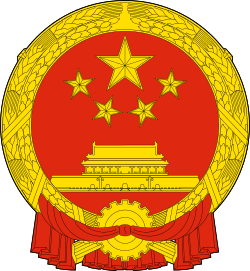Liberalism in China
| This article is part of a series on the |
| Politics of the People's Republic of China |
|---|
 |
| Commonly known as China |
|
|
|
China portal |
Liberalism in China or Chinese liberalism resulted from the introduction of classical liberalism into China during the period of Western domination towards the end of the Qing Dynasty (1644-1911). Translations of John Stuart Mill, Herbert Spencer, Immanuel Kant, Jean-Jacques Rousseau and many other writers had a cumulative effect, as did the ascendancy of liberalism in world powers like Britain, France and the United States. The establishment of the Republic of China in 1911-12 signaled the acceptance (at least in principle) of these models and the liberal values with which they identified, such as constitutionalism and the separation of powers.
The writings of Liang Qichao (1873-1929) played a major role, despite his leanings to a conservative outlook in latter years. The New Culture Movement (1915-) and its immediate successor the May Fourth Movement (1919) initially were strongly liberal in character, with key figures like Hu Shi (1891-1962) as the preeminent exponent of liberal values. Other important liberals were Zhang Dongsun (1886-1976) and Zhang Junmai (1887-1969).
Liberalism was to suffer in the wake of the immense challenges China faced from Japanese militarism and the impact of the Communist movement. By the 1930s many of the younger generation felt that only radical, authoritarian doctrines could save the country. The Guomindang or Nationalist party absorbed a good deal of Fascist doctrine and practice. Liberalism increasingly seemed to serve as a forlorn "third force", able only to admonish authoritarian regimes of the Left and Right. Writers such as Chu Anping, however, made a strong case against the Nationalists; educators and scholars such as Fei Xiaotong and Tao Xingzhi made a case for revolution as a cause worthy of liberal support; while many more liberals left China, including the rural reformer James Yen, the university president Chiang Monlin, and many less well known figures.
The ascendancy of Mao Zedong and the establishment of the People's Republic of China in 1949 brought the liberal impulse to its lowest level. Ideological witchhunts were organized against the (real or imaginary) followers of Hu Shi, and their values were ceaselessly derided as bourgeois delusions which could only weaken the nation.
With the collapse of Mao's ideology on his death, seeds of regeneration which had lain dormant gradually came to life. Liberal ideals like intellectual freedom, the separation of powers, civil society and the rule of law were reexamined in the light of the destruction wrought by the Communist party which had been so vociferous in denigrating them. Starting in the Cultural Revolution, many younger people experienced virtual conversions to liberalism. This process was given further impetus by the Tiananmen Square protests leading up to the massacre of June 4, 1989. The democracy movement espoused (however imperfectly) many liberal doctrines. Among the key figures were Wang Ruoshui (1926-2002), who while remaining a Marxist humanist reconfigured this doctrine along liberal lines, and Liu Xiaobo (b. 1955), initially a literary critic, who broke with Marxism to combine existentialist themes with liberalism.
In the 1990s the liberal wing of the remnant of the pro-democracy movement re-emerged following the Tiananmen crackdown, including figures like Qin Hui, Li Shenzhi, Zhu Xueqin, Xu Youyu, Liu Junning and many others. The writings of Gu Zhun (1915-1974) were rediscovered, providing evidence of a stubborn core of liberal values that the communist movement had failed to extinguish. Ranged against the liberals are the Chinese New Left and populist nationalism.
Chinese liberalism itself tends to divide into market liberalism, impressed by the US as a political model and adhering to the doctrines of Hayek and other neoliberals, and left-liberalism, more aligned with European social democracy and the welfare state. These tendencies continue to evolve in an uneasy state of tension. Nonetheless Chinese liberalism has clearly emerged in its social democratic form is even influencing the doctrinal evolution of the Chinese Communist Party.
See also
References
- Liberalism by Max Lerner
- Edmund Fung, The Intellectual Foundations of Chinese Modernity: Cultural and Political Thought in the Republican Era, Cambridge: Cambridge University Press, 2010.